Pied
Recessive Mutation
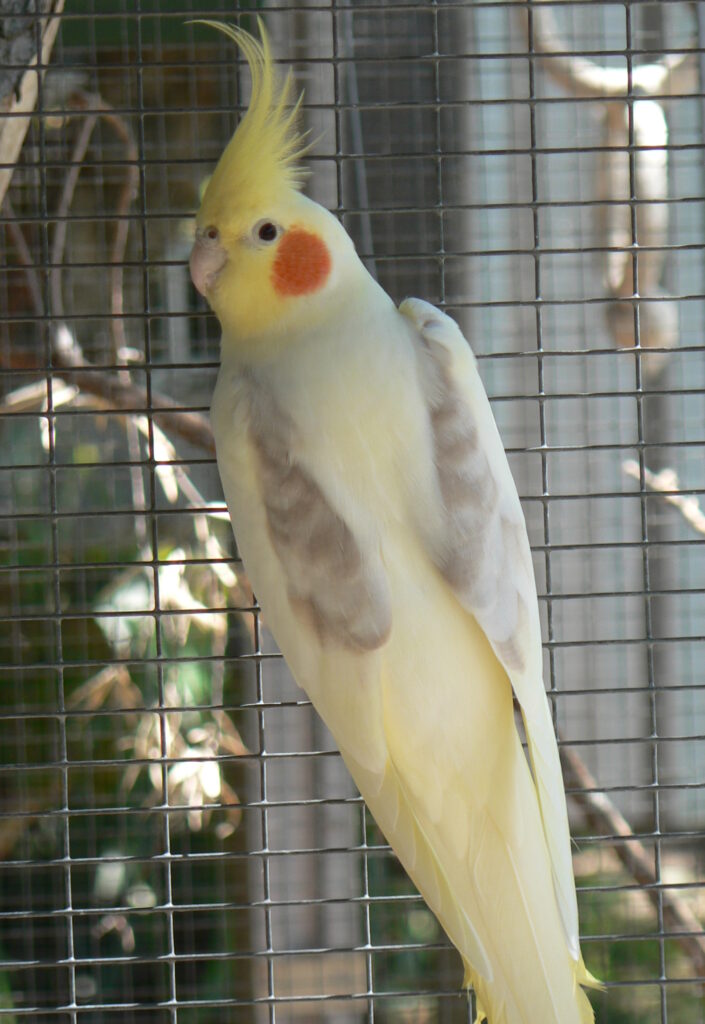
The Pied Cockatiels gene has the effect of disrupting the placement of body colour pigments in a random pattern. The pattern can vary greatly from bird to bird and also the amount of pattern will differ greatly also. One mistake people make when describing a pied cockatiel is to think that the pied area is the grey or main body colour. This is in fact incorrect. The pied gene takes away the main body colour so it is actually the yellow or white areas that are the result of the pied genes actions.
A light pied bird would thus have a larger amount of the normal body colour and less white or yellow. By normal I mean the original body colour that the pied has acted upon..ie a cinnamon pied would have cinnamon as it’s body colour. A heavy pied would thus be a bird with lots of pied areas..ie. yellow or white, and less of the normal body colour.
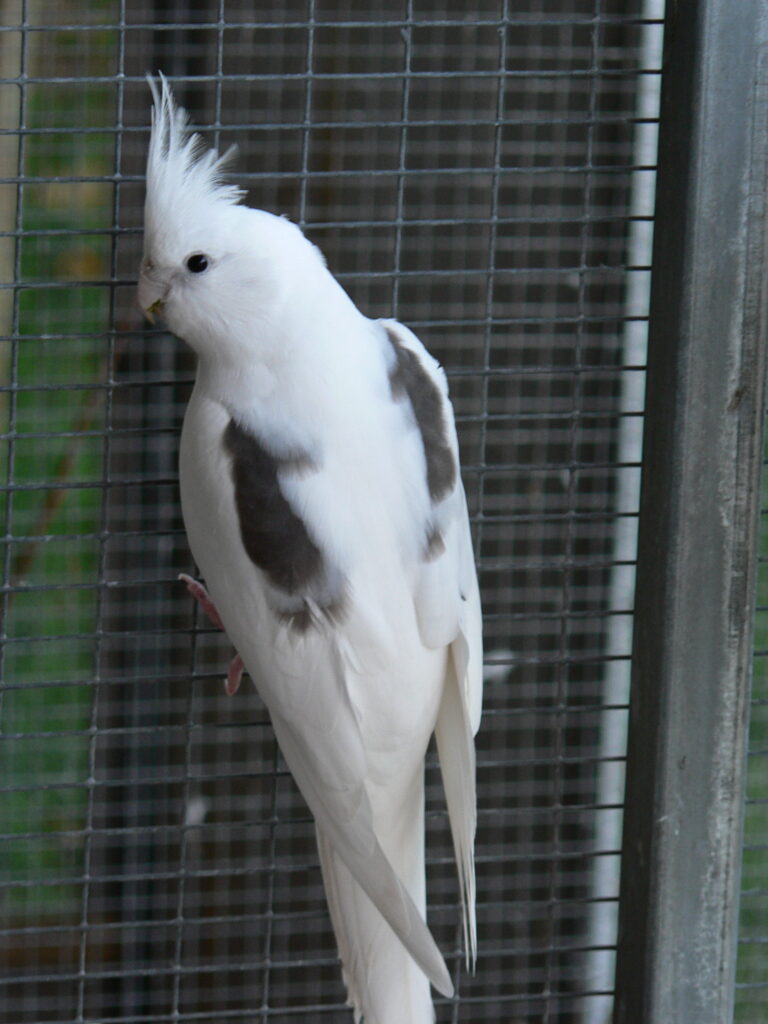
These 2 pictures show the difference between Heavy Pied Cockatiels (left) and Light Pied Cockatiels (right). Technically speaking, a light pied bird should have 25% pied and 75% body colour and a heavy pied should show 25% body colour and 75% pied colour. Naturally in a whiteface bird the pied colour would be white instead of yellow. Ideally a perfect specimen would have 25% body colour with an even pattern to the markings and an absence of body colour from the face, tail and flights. Birds with dark feathers on the face are called ‘dirty-face’ pieds.
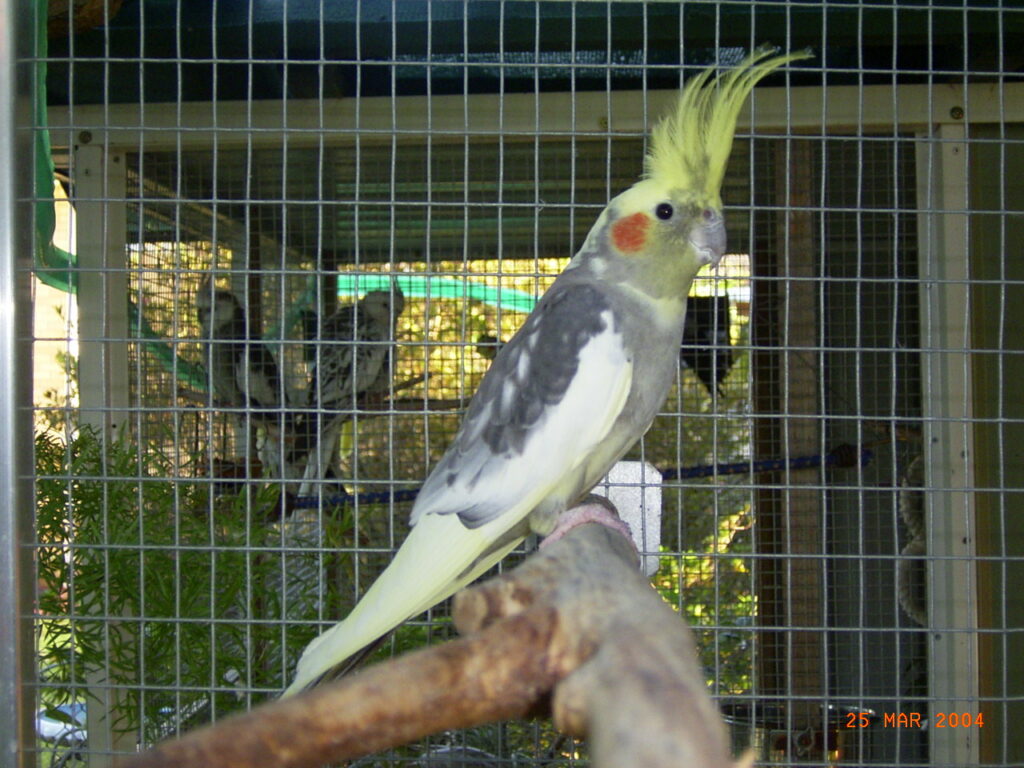
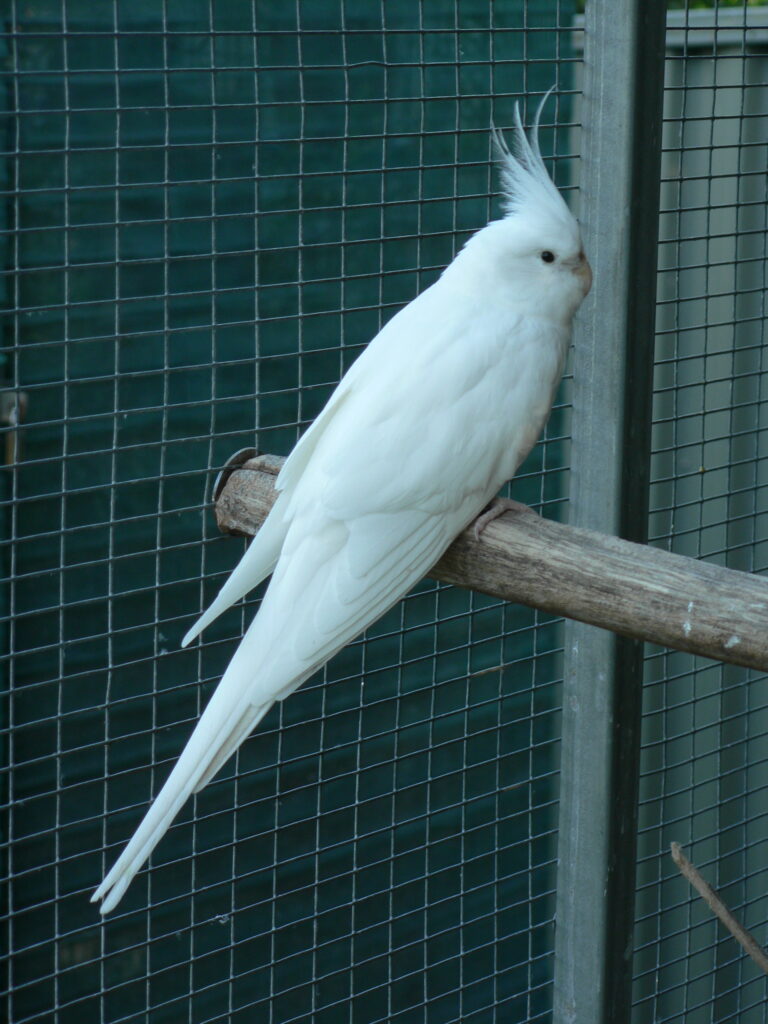
As well as light and heavy pieds you will also hear the term ‘reverse’ pied and ‘clear’ pied. A ‘reverse’ pied is one that has very little dark or body colour and is mostly yellow or white. A ‘clear’ pied is one in which the pied gene has effectively prevented all melanin from being deposited in the feathers and thus looks like a lutino bird or whiteface lutino depending which we are referring to. The distinguishing feature between these 2 colours and a clear pied will be the eye colour. A pied bird that would normally have dark eyes with it’s normal body colour will still have dark eyes. The pied gene does not change eye colour. So a clear cinnamon pied will be a yellow bird with normal eyes for a cinnamon whereas a lutino would be yellow with red eyes.
Having explained the action of the pied gene on the normal coloured bird and the correct naming of it we must now move on to another visual aspect the pied gene effects.
The Pied Cockatiels gene is what is referred to as Recessive ADM…or Recessive Anti-Dimorphism. Don’t panic about this description as it is relatively easy to understand. Anti-dimorphism basically means that the normal visual characteristics that are used to tell the difference between hens and cock birds no longer exist. For example the yellow face on a normal coloured bird would usually denote the bird is a male. In an ADM pied bird the yellow face could be a hen. Also the tail barring and wingspots on hens in normal birds can be found on pied cock birds. Naturally when I say yellow I am referring to non-whiteface birds as in whiteface birds the colour would be white.
A pied bird can be determined from as young as pin feather stage. The pins on the crest will always appear yellow or white and not the normal body colour of the bird.
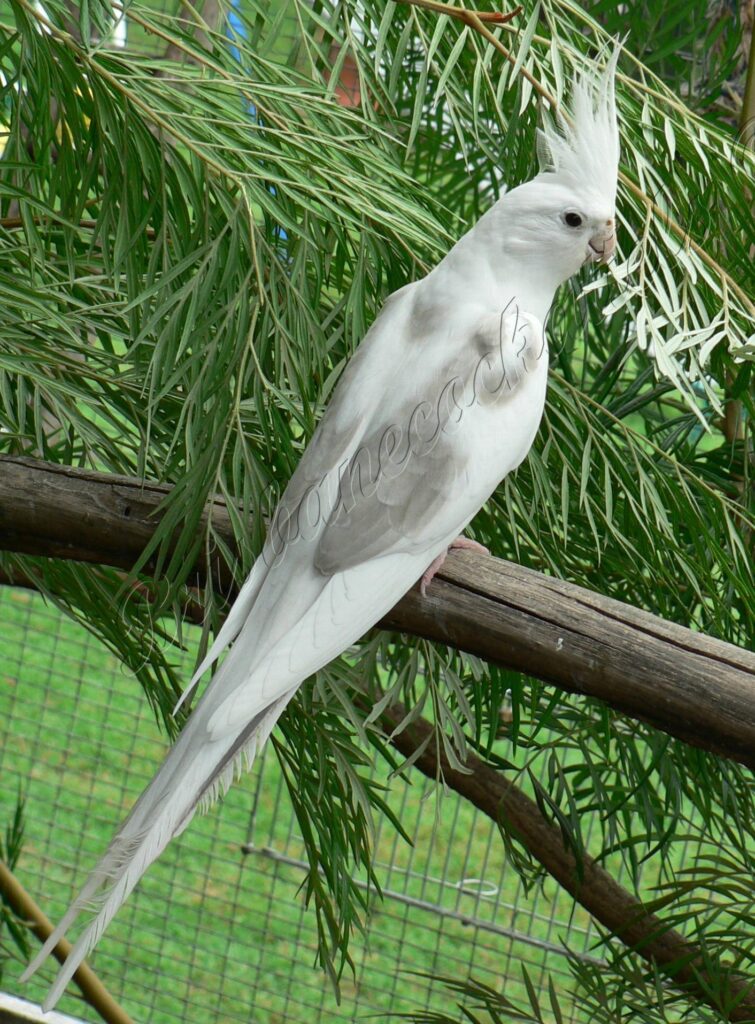
Here is an example of the lack of distinguishing features between cocks and hens. Both are whiteface pied birds and both have the white face that normally would denote a cock bird. The bird on the left however is a whiteface platinum pied hen and the one on the right is a whiteface pied cock. Just looking at the two pictures it is impossible to determine the sex.
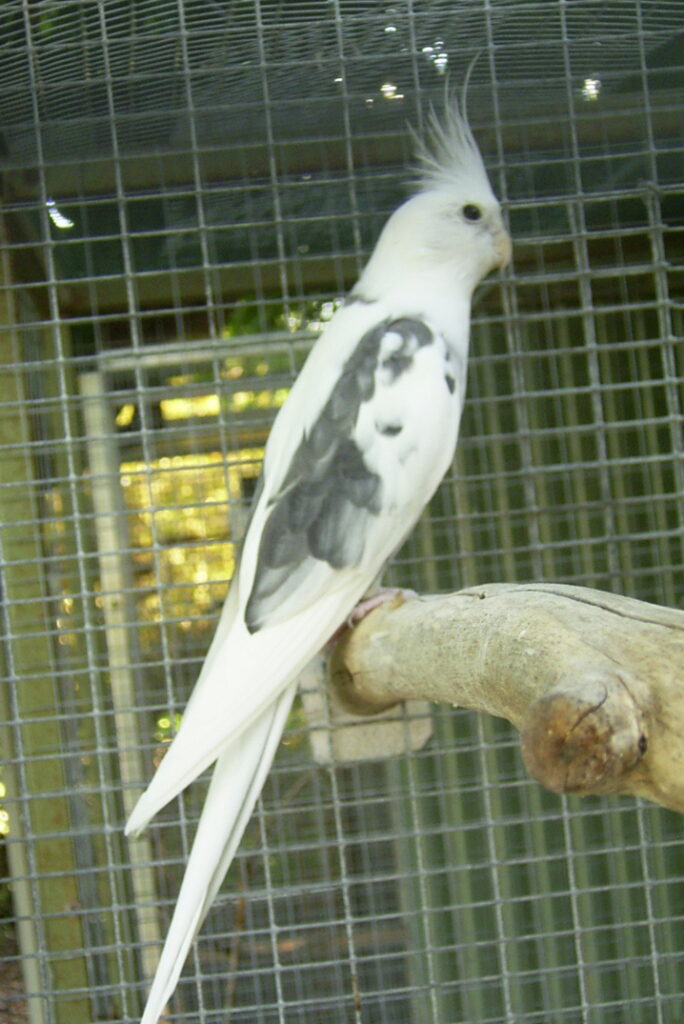
Heredity
The pied gene is a recessive mutation. This means that one single gene on it’s own will not create a pied bird. A bird must receive a pied gene from it’s mother and father to be a visual pied. Keep in mind that all genes are found on a birds chromosomes and each chromosome comes in a pair. Each gene has a set position on a chromosome where it resides and if the gene isn’t present in that position a normal or wild-type gene fills the spot. To create the visual appearance these 2 genes both have their say. If it has only one pied gene then on the position where a pied gene would sit on it’s partner chromosome there would be a wild-type or normal gene. Because the normal gene is a dominant gene it would prevent the single pied gene from being visible and thus the bird would be split to pied. However if a pied gene is present on both then the pied effect will be visible as no wild-type gene is present to dominate over the pied.
However by now some of you will be saying “but my bird is split pied and I can see patches of colour on the back of it’s head”. Yes it is true! A bird that has only one pied gene and thus called ‘heterozygous’ can display pied markings. In the ‘heterozygous’ state in other recessive mutations, the bird would usually be a normal colour and show no signs of that particular recessive mutation being present. With pied however, this is not the case. Some birds, but not all, that are only split will show markings such as patching on the head, or a pink toenail or stripe on the beak where it would normally be dark. This often leads to the thought that maybe the pied gene is actually dominant. However to call a gene dominant it must be visual 100% of the time in all heterozygous or split birds. As this isn’t the case with the pied gene, ie some split pied birds show no visual evidence of pied being present, experts feel it is safer to keep the inheritance mode as recessive until it can be proven otherwise.
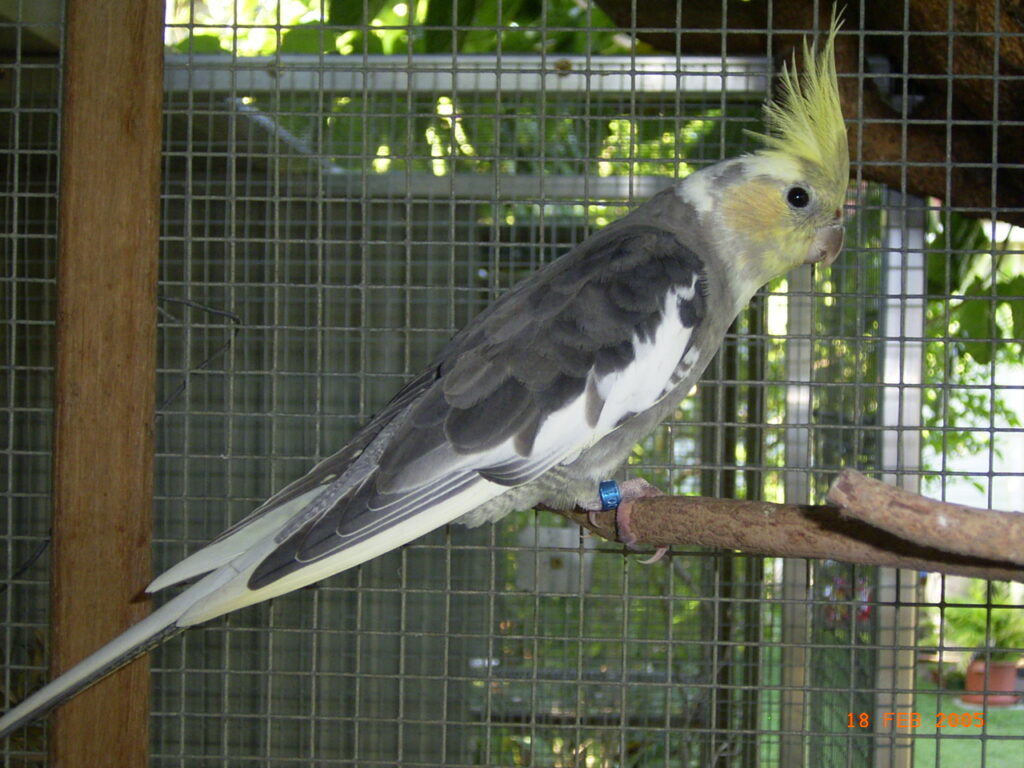
These 2 birds are both split pied so only have one pied gene. There is a great variation in the amount and position of the pied markings.
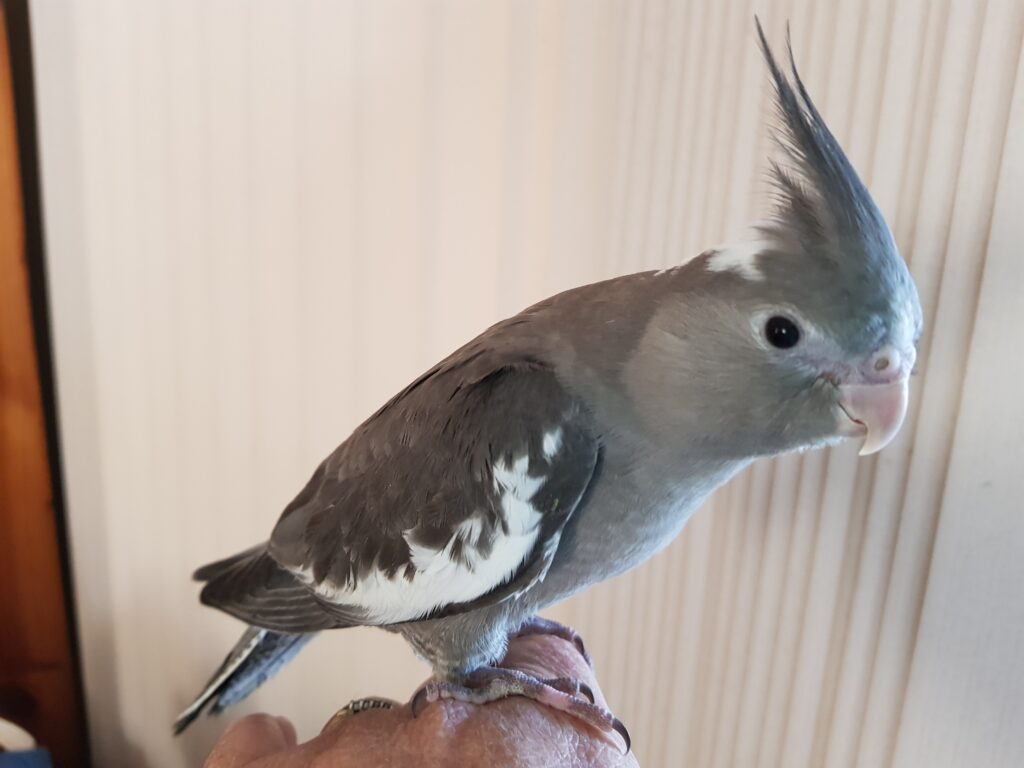
Pied inheritance – more complicated than we like to view it
By Dr Terry Martin BVSc
This article reprinted from ANCS journal with permission
The article in the September-October Journal of the ANCS by Pieter Klapwijk raised questions about the inheritance of the Pied mutation in Cockatiels. Similar questions have been raised by breeders in a number of other parrot species with regards the inheritance of Recessive Pieds,
particularly here in Australia where it is becoming popular for some breeders to view them as codominant.
I write this article in response to this article to try to explain some of the complexity involved with the inheritance of Pied mutations and why this mutation in Cockatiels is correctly recognised as recessive.
Pieter Klapwijk’s article focuses on the ratios of gene inheritance to subsequent generations and it is a fact that the ratios are always identical irrespective of the mode of inheritance. When defining the mode of inheritance, the simplest rule is to determine which phenotype is produced
by the first cross of Pied X wildtype. If the result of this first cross is 100% wildtype, then the inheritance is recessive. If the offspring are 100% the same as the parent, then the inheritance is dominant. If the appearance is midway between the two parents (in 100% of offspring), then it
reflects co-dominant inheritance.
In a true dominant Pied mutation, as exists in Budgerigars, Peachface Lovebirds and some other species, all youngsters from this first cross are unmistakably Pieds, very similar in degree of pied markings to their parents, allowing for the inevitable degree of variation seen in all Pieds. These
are true dominant Pieds. In contrast, when a Cockatiel is bred like this, the youngsters produced are no where near the Pied parents phenotype, they are instead almost wildtype, but with a few ‘pied’ markings. At first this may seem to indicate a co-dominant mutation, however in that situation the heterozygous (SF bird) is midway between the two parents in colour. Whereas the birds produced by Pied outcrosses have much less than 10% pied pattern, irrespective of the degree of Pied markings in their parent. That is not co-dominant inheritance.
Pieter Klapwijk raised the question whether any ‘splits’ ever are pure wildtype in appearance and the answer is yes. In the early days of the Pied mutation, dating back to when they first became available publicly in Australia in the late 70’s /early 80’s, most split birds showed no sign of pied
markings. So why do so many ‘splits’ show these markings today? The answer lies within the selectable variation we see in Pieds in all species of animals. Those early Pieds had on average far less pied pattern than today’s birds. Why have they changed? Because breeders have been selecting for ‘better’ pied markings and in doing so are selecting for modifiers to ‘improve’ the basic Pied pattern produced. And it is these modifiers that are causing the ‘break through’ pied markings in many of the splits and causing breeder’s confusion about the inheritance. Exactly the same thing has been seen in all other species of birds with recessive Pied mutations.
The ‘modifiers’ are actually a collection of dominant minor pied genes, recessive minor pied genes and true modifiers. In total there are perhaps 10-15 different ones that can be ‘collected’ together to produce the enormous range of markings we see in different Pied Cockatiels. But they all rely on the one major Recessive Pied gene to give them significant expression. Without the major gene, the modifiers and recessive genes will not even make themselves apparent. The Minor pied genes, on the other hand, show themselves with small degree pied patterns, and it is these that produce the ‘visible splits’. In themselves they only produce a pattern of less than 10% pied markings. These markings are always in the same regions in every species – back of the head and the extremities – wing flights, tail and feet.
Many of these minor genes are desirable and their selection important to produce a high quality pied. So what is the harm in viewing these birds as ‘SF Pieds’? This problem has already been seen in Rainbow Lorikeets in Australia. Breeders who view these are dominant traits then mate
the ‘SF birds’ across Normals to produce more ‘SF birds’ which they can then sell to other breeders. But since the trait is due to a separate minor Pied gene, it can be inherited independently of the important major Recessive Pied gene and before long these ‘SF birds’ no longer carry the major Pied gene. In Rainbow Lorikeets the ‘Streaky head’ gene is a dominant minor Pied gene independent to the major Recessive Pied gene. Breeders are producing ‘Streaky heads’ and selling them as ‘SF birds’ but many of these birds only ever produce more ‘Streaky head’, never any good Pieds in future generations because they no longer carry the major gene.
It is also important to understand the recessive nature of these genes if the hobby to prevent the loss of non Pied birds altogether. In canaries the pied gene (referred to as variegation in this species) is carried by almost 100% of individuals. And in Bengalese finches until very recently,
all Australian birds carried the Pied gene. Dominant genes can be easily selected against, but if breeders try to remove the Pied gene from Cockatiel strains, then the modifiers will be easily selected against but not the hidden recessive genes (both major and minor).
For many breeders it becomes a matter of semantics whether they view the Pied mutation as recessive or dominant. But if breeders lose sight that the major gene is the most important aspect, then they can quickly lose the higher quality Pied birds. Cockatiel breeders have managed to produce high quality Pieds by viewing the mutation as recessive and then using the existence of all the modifiers and minor genes to perfect the pattern produced.
Reach Out To Us
Interested in adding a new feathered family member or learning more? Reach out to us by clicking on the button below.